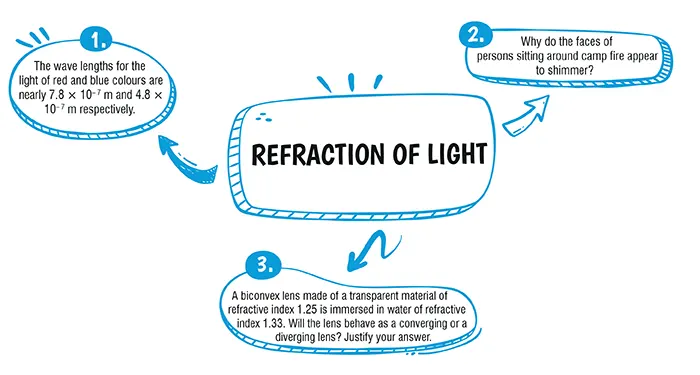Table of Contents

Ans. (d) both (a) and (b)
Explanation:
Refractive index is quite high in diamond. This characteristic explains why diamonds sparkle. The diamond crystal sparkles because light penetrates it and is reflected numerous times internally.
Ans. (c) it is travelling from optically rarer medium to a optically denser medium
Explanation:
When a light ray enters from one optical medium to another and bends towards the normal then speed of light decreases as it travels from rarer to denser medium.
Explanation:
The wave lengths for the light of red and blue colours are nearly 7.8 × 10^{– 7} m and 4.8 × 10^{– 7} m respectively.
(i) Both colours of light have same speed in vacuum.
(ii) In glass, speed of red light is more than that of blue light.
Explanation:
The rays coming from the face of a person, sitting across the camp fire, suffer refraction on passing through hot air. Thus, we see an apparent image of the person. Since hot air is in motion, therefore, its optical density changes, which in turn shifts the image rapidly. This rapidly shifting image gives a shimmering effect.
Explanation:
Generally, a biconvex lens acts as a converging lens in air because the refractive index of air is less than that of the material of the lens. The refractive index of water (1.33) is more than the refractive index of the material of the lens (1.25). So, on immersing in water it will behave as a diverging lens.
Download Mind Map of this chapter
Download NowWant to Practice Mock Tests of this chapter
Practice NowDownload Important Questions of this chapter
Download Now| Chapter No. | Chapter Name |
|---|---|
| Chapter 1 | Force Work Power and Energy |
| Chapter 2 | Simple Machines |
| Chapter 3 | Refraction of Light |
| Chapter 4 | Refraction Through Lenses |
| Chapter 5 | Spectrum |
| Chapter 6 | Sound |
| Chapter 7 | Electricity |
| Chapter 8 | Electrical Power and Household Circuits |
| Chapter 11 | Magnetic Effect of Current |
| Chapter 12 | Specific Heat Capacity and Latent Heat |
| Chapter 13 | Radioactivity and Nuclear Energy |
| Chapter Wise Important Questions for ICSE Board Class 10 Physics |
|---|
| Force Work Power and Energy |
| Simple Machines |
| Refraction of Light |
| Refraction Through Lenses |
| Spectrum |
| Sound |
| Electricity |
| Electrical Power and Household Circuits |
| Magnetic Effect of Current |
| Specific Heat Capacity and Latent Heat |
| Radioactivity and Nuclear Energy |
CBSE Important Questions Class 10
ICSE Important Questions Class 10
CBSE Important Questions Class 10
ICSE Important Questions Class 10